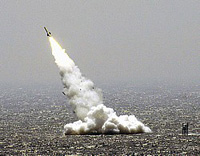Russia launches serial production of Bulava missiles to minimize US missile defense efforts
Russian defense enterprises have launched the serial production of Bulava strategic missiles. “The funding is being conducted as stipulated,” Vice Prime Minister Sergei Ivanov said Monday at a meeting of the presidium of the Russian government. Russia will conduct another test launch of the Bulava missile until the end of 2008, whereas the tests in general will be completed in 2009, Itar-Tass reports.

Mr. Ivanov reminded that Russia carried out the tenth launch of its Bulava strategic missile on November 28, of which only five were successful. “All the measurements were in order – both the launch of the missile from the Dmitry Donskoy nuclear submarine and the work of the three missile stages, including the work of the post-boost vehicle. All the warheads landed where they were supposed to land,” Ivanov said.
The intercontinental solid-fuel ballistic missile Bulava was designed by the Moscow Institute of Thermal Technology. The missile is capable of carrying up to ten individually guided nuclear blocks and striking targets within a radius of up to 8,000 kilometers. The missile is designed for Borei class nuclear submarines, which will be outfitted with 16 missiles each. The heavy nuclear-powered submarine Dmitry Donskoy was prepared to conduct the missile tests. Several test launches of the Bulava missile ended unsuccessfully in 2007.
The Bulava carries the NATO reporting name SS-NX-30 and has been assigned the GRAU index 3M30. In international treaties, the common designation RSM-56 is used.
The decision on developing the “Bulava” missile was adopted in 1998 after three unsuccessful tests of the “Bark” missile of the Miass Construction Bureau named after Makeev.
The Bulava design is based on the SS-27 (Topol M), but is both lighter and more sophisticated. The two missiles are expected to have comparable ranges, and similar CEP and warhead configurations.
The Russian military developed Bulava to possess advanced defense capabilities making it nearly impervious to existing and future missile-defense systems. Among its claimed abilities are evasive maneuvering, mid-course countermeasures and decoys and a warhead fully shielded against both physical and EMP damage. The Bulava is designed to be capable of surviving a nuclear blast at a minimum distance of 500 meters. Prime Minister Putin has stated that Bulava could penetrate any potential anti-missile defense system.
The current version of the Bulava is able to carry up to six MIRV warheads, future variants are expected to carry a maximum of ten. A full-capacity payload requires the forfeiture of all final stage countermeasures and of some shielding.
The missile completed the first stage launch-tests at the end of 2004. It was originally scheduled for completion in late 2006, but is now not expected to enter service until 2009.
Subscribe to Pravda.Ru Telegram channel, Facebook, RSS!





